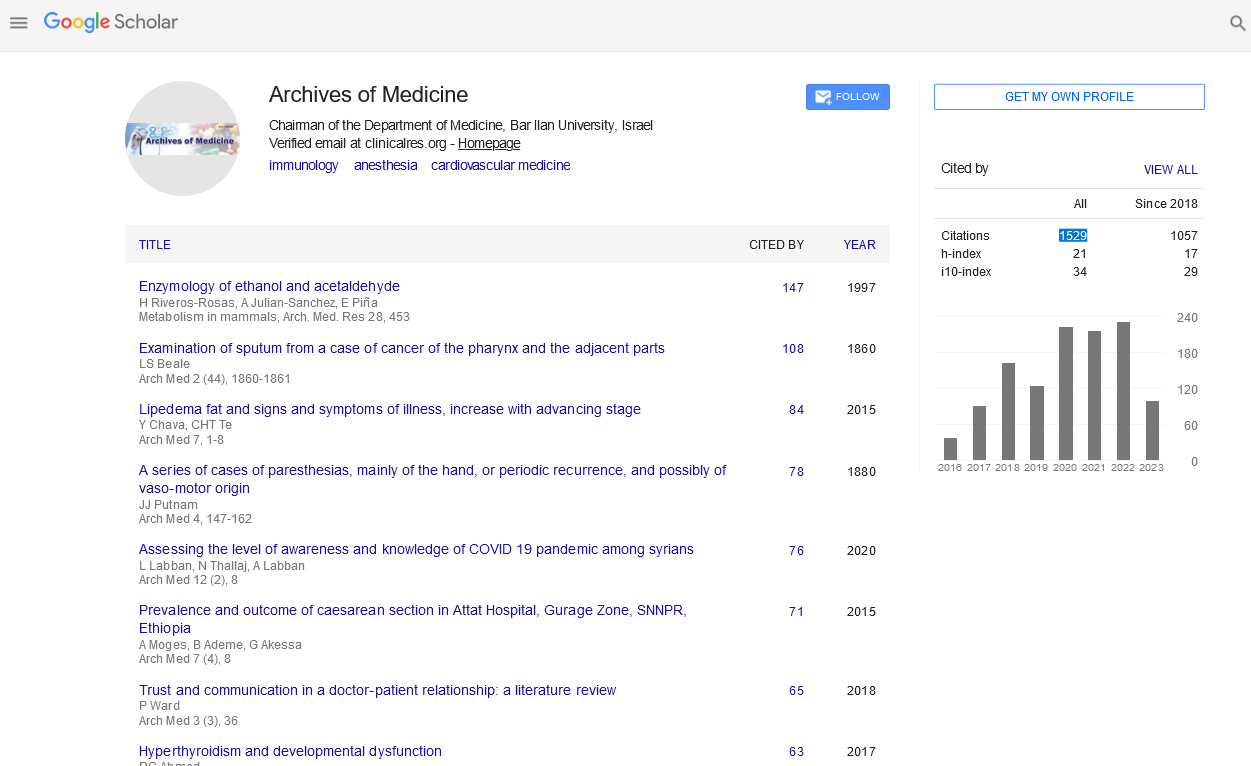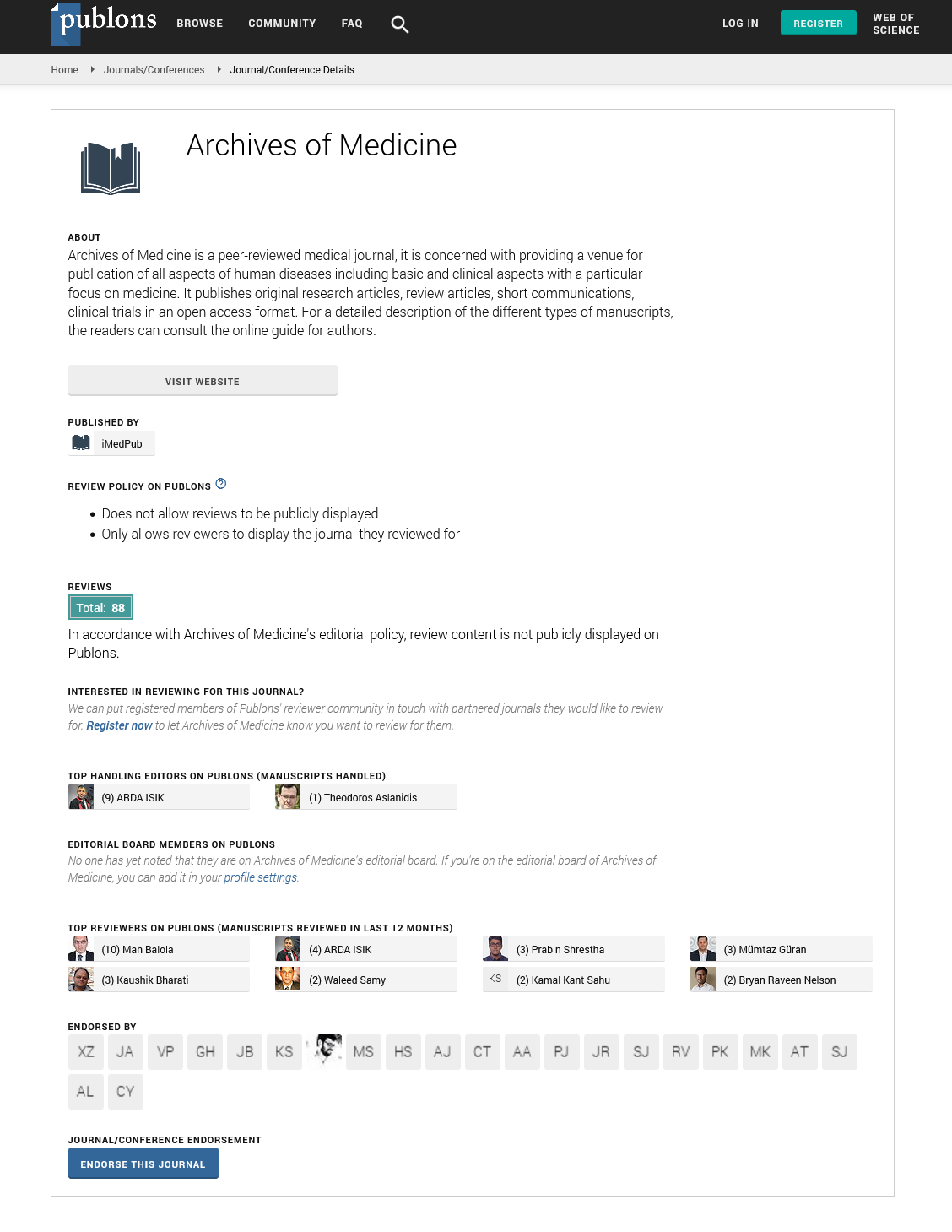Review Article - (2024) Volume 16, Issue 3
Clinical applications of anatomic pathology techniques
Serena Murphy*
Department of Medicine, Tufts University School of Medicine, MA, USA
*Correspondence:
Serena Murphy, Department of Medicine, Tufts University School of Medicine, MA,
USA,
Email:
Received: 01-May-2024, Manuscript No. ipaom-24-14992;
Editor assigned: 03-May-2024, Pre QC No. P-14992;
Reviewed: 15-May-2024, QC No. Q-14992;
Revised: 22-May-2024, Manuscript No. R-14992;
Published:
29-May-2024
Abstract
Anatomic pathology techniques are pivotal in modern clinical practice,
offering essential diagnostic insights through the detailed examination
of tissue samples. This abstract explores the diverse methodologies
employed in anatomic pathology, including histopathology,
immunohistochemistry, molecular diagnostics, and cytogenetic. These
techniques enable the precise identification and characterization
of diseases at the cellular and molecular levels, facilitating tailored
treatment strategies and personalized patient care. The application of
these methodologies spans a wide spectrum of medical disciplines,
from oncology to infectious diseases, highlighting their integral role
in guiding clinical decision-making and improving patient outcomes.
Clinical applications of anatomic pathology techniques encompass a
wide array of diagnostic methods used to analyze tissue samples for the
detection and characterization of diseases. These techniques include
detailed microscopic analysis, molecular testing, histopathology,
immunohistochemistry, molecular diagnostics, and cytogenetics,
each providing critical insights into disease mechanisms and guiding
personalized treatment strategies and disease management in clinical
settings.
Keywords
Anatomic pathology; Clinical diagnostics; Histopathology;
Immunohistochemistry; Molecular diagnostics; Cytogenetics; Tissue
analysis; Disease characterization
Introduction
Anatomic pathology stands as a cornerstone in the field
of medicine, offering invaluable insights into the nature,
progression, and treatment of diseases through the examination
of tissues and organs at a microscopic level. This branch of
pathology plays a fundamental role in clinical diagnostics,
providing clinicians with crucial information necessary for
accurate disease identification and characterization. At its core,
anatomic pathology encompasses various specialized techniques
aimed at scrutinizing tissue samples obtained through biopsies,
surgeries, or autopsies. Histopathology, one of the foundational
methods, involves the microscopic examination of stained tissue
sections to discern structural abnormalities indicative of disease.
This technique not only allows pathologists to identify cancerous
cells but also provides insights into the extent of tissue damage
caused by infectious agents, autoimmune disorders, or other
pathological conditions.
In addition to histopathology, anatomic pathology includes
advanced methodologies such as immunohistochemistry and
molecular diagnostics. Immunohistochemistry utilizes specific
antibodies to detect and localize proteins within tissue samples,
aiding in the classification of tumors and determination of
treatment options based on biomarker expression. Molecular
diagnostics, on the other hand, employs techniques like Polymerase
Chain Reaction (PCR) and Next-Generation Sequencing
(NGS) to analyze genetic mutations and alterations at the
DNA or RNA level, providing personalized insights into disease
mechanisms and guiding targeted therapies. The significance of
anatomic pathology extends beyond mere diagnosis; it influences
patient management strategies by facilitating precise prognostic
assessments and therapeutic decision-making. Whether in the
context of oncology, infectious diseases, or systemic disorders, the
ability to accurately interpret tissue findings is instrumental in
tailoring treatment regimens to individual patient needs.
Literature Review
Anatomic pathology serves as a critical discipline within
medicine, utilizing various techniques to examine tissue samples
for diagnostic purposes. The field has evolved significantly,
integrating advanced technologies and methodologies that enhance
its diagnostic accuracy and clinical relevance. Histopathology
remains foundational in anatomic pathology, involving the
microscopic examination of tissue sections stained with dyes to
reveal cellular structures and abnormalities. This technique is
indispensable for identifying cancers, inflammatory conditions,
and structural changes indicative of disease progression.
The development of digital pathology has revolutionized
histopathology by enabling remote consultation, collaboration,
and the application of artificial intelligence for image analysis,
thereby improving diagnostic efficiency and reproducibility [1].
Immunohistochemistry (IHC) has become integral in
characterizing tumors and guiding treatment decisions by
detecting specific proteins or antigens within tissue samples.
By leveraging antibodies tagged with markers visible under microscopy, IHC assists pathologists in sub classifying cancers,
predicting patient outcomes, and selecting appropriate therapeutic
strategies [2]. Molecular diagnostics represents another pivotal
advancement in anatomic pathology, focusing on genetic and
molecular alterations within tissues. Techniques such as PCR,
NGS, and Fluorescence in Situ Hybridization (FISH) enable the
detection of mutations, gene amplifications, and chromosomal
rearrangements associated with various diseases. This molecular
insight is particularly crucial in oncology, where targeted
therapies tailored to individual genetic profiles have transformed
treatment paradigms and improved patient outcomes. The
integration of these technologies underscores the evolving role
of anatomic pathology in personalized medicine. By combining
morphological assessments with molecular and genetic analyses,
pathologists can provide comprehensive diagnostic reports that
inform precise treatment plans and prognostic predictions.
Moreover, advancements in bioinformatics and data analytics
have facilitated the management and interpretation of complex
molecular data, further enhancing the utility of anatomic
pathology in clinical practice [3,4].
Discussion
Anatomic pathology plays a pivotal role in modern medicine
by providing critical diagnostic insights through the examination
of tissue samples. This discipline encompasses a range of
specialized techniques, each offering unique advantages in the
characterization and understanding of diseases.
One of the primary contributions of anatomic pathology
is its ability to detect and classify various diseases based on
microscopic examination. Histopathology, for instance, allows
pathologists to visualize cellular and tissue structures, identifying
abnormalities indicative of conditions such as cancers, infections,
and autoimmune disorders. This visual assessment forms the
cornerstone of diagnostic pathology, guiding clinicians in
formulating accurate treatment plans and prognosticating
patient outcomes [5]. Beyond traditional histopathology, the
integration of immunohistochemistry (IHC) has significantly
enhanced diagnostic precision. IHC employs specific antibodies
to detect and localize proteins within tissue samples, aiding in
the classification of tumors and the prediction of therapeutic
responses based on biomarker expression. This technique has
revolutionized oncological practice by enabling the identification
of molecular targets for tailored therapies, thereby improving
patient management and survival rates.
Furthermore, the advent of molecular diagnostics has
expanded the capabilities of anatomic pathology by focusing
on genetic and molecular alterations within tissues. Techniques
such as Polymerase Chain Reaction (PCR), Next-Generation
Sequencing (NGS), and Fluorescence in Situ Hybridization
(FISH) allow for the detection of mutations, gene amplifications,
and chromosomal rearrangements associated with diseases. This
molecular insight not only enhances diagnostic accuracy but also
supports the development of personalized treatment strategies in fields like oncology, where targeted therapies based on genetic
profiles have become standard practice. The ongoing evolution
of anatomic pathology is also shaped by advancements in digital
pathology and Artificial Intelligence (AI). Digital pathology
enables the storage, analysis, and sharing of high-resolution
images, facilitating remote consultations and collaborative
diagnostic efforts. AI algorithms applied to digital pathology
data promise to automate routine tasks, improve diagnostic
consistency, and uncover subtle patterns that may escape human
observation [6].
Conclusion
In conclusion, anatomic pathology continues to evolve as
a dynamic and indispensable discipline within medicine. Its
integration of advanced technologies and methodologies ensures
that clinicians receive accurate and timely diagnostic information,
ultimately enhancing patient care and outcomes across diverse
medical specialties. As research and technology continue to
evolve, anatomic pathology remains at the forefront of medical
innovation, driving improvements in diagnostic precision,
therapeutic efficacy, and personalized medicine.
Acknowledgment
None.
Conflict of Interest
None.
References
- Hanna MG, Reuter VE, Samboy J, et al. Implementation of digital pathology offers clinical and operational increase in efficiency and cost savings. Arch Path Lab Med. 2019; 143(12):1545-1555.
Google Scholar, Crossref, Indexed at
- Rodriguez-Canales J, Parra-Cuentas E, Wistuba II. Diagnosis and molecular classification of lung cancer. Lung Cancer: Treat Res. 2016:25-46.
Google Scholar, Crossref, Indexed at
- Hunt JL. Molecular pathology in anatomic pathology practice: A review of basic principles. Arch Path Lab Med. 2008; 132(2):248-260.
Google Scholar, Crossref, Indexed at
- Pisapia P, L’Imperio V, Galuppini F, et al. The evolving landscape of anatomic pathology. Crit Rev Oncol Hematol. 2022; 178:103776.
Google Scholar, Crossref, Indexed at
- Jahn SW, Plass M, Moinfar F. Digital pathology: Advantages, limitations and emerging perspectives.
J Clin Med Res. 2020; 9(11):3697.
Google Scholar, Crossref, Indexed at
- Clay MR, Fisher KE. Bioinformatics education in pathology training: Current scope and future direction. Cancer Inform. 2017; 16:1176935117703389.
Google Scholar, Crossref, Indexed at






